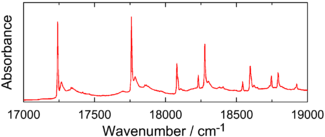Shpolskii matrix

Shpolskii systems are low-temperature host-guest systems - they are typically rapidly frozen solutions of polycyclic aromatic hydrocarbons in suitable low molecular weight normal alkanes. The emission and absorption spectra of lowest energy electronic transitions in the Shpolskii systems exhibit narrow lines instead of the inhomogeneously broadened features normally associated with spectra of chromophores in liquids and amorphous solids. The effect was first described by Eduard Shpolskii in the 1950s[1] and 1960's[2][3][4] in the journals Transactions of the U.S.S.R. Academy of Science s and Soviet Physics Uspekhi.
Subsequent detailed studies of concentration and speed of cooling behavior of Shpolskii systems by L. A. Nakhimovsky and coauthors led to a hypothesis that these systems are metastable segregational solid solutions formed when one or more chromophores replace two or more molecules in the host crystalline lattice. The solid state quasi-equilibrium solubility in most Shpolskii systems is very low. When the Shpolskii effect is manifested, the solid state solubility increases two to three orders of magnitude.[5][6] Isothermic annealing of the supersaturated rapidly frozen solutions of dibenzofuran in heptane was performed, and it was shown that the return of the metastable system to equilibrium in time reasonable for laboratory observation required the annealing temperature to be close to the melting temperature of the metastable frozen solution.[7] Thus the Shpolskii systems are an example of a persistent metastable state.
A good match between the chromophore and the host lattice leads to a uniform environment for all the chromophores and hence greatly reduces the inhomogeneous broadening of the electronic transition's pure electronic and vibronic lines. In addition to the weak inhomogeneous broadening of the transitions, the quasi-lines observed at very low temperatures are phonon-less transitions.[8] Since phonons originate in the lattice, an additional requirement is weak chromophore-lattice coupling. Weak coupling increases the probability of phonon-less transitions and hence favors the narrow zero phonon lines.[9] The weak coupling is usually expressed in terms of the Debye-Waller factor, where a maximum value of one indicates no coupling between the chromophore and the lattice phonons. The narrow lines characteristic of the Shpolskii systems are only observed at cryogenic temperatures because at higher temperatures many phonons are active in the lattice and all of the amplitude of the transition shifts to the broad phonon sideband. The original observation of the Shpolskii effect was made at liquid nitrogen temperature (77 kelvins), but using temperatures close to that of liquid helium (4.2 K) yields much sharper spectral lines and is the usual practice.
Low molecular weight normal alkanes absorb light at energies higher than the absorption of all pi-pi electronic transitions of aromatic hydrocarbons. They interact weakly with the chromophores and crystallize when frozen. The length of the alkanes is often chosen to approximately match at least one of the dimensions of the chromophore, and are usually in the size range between n-pentane and n-dodecane.
See also
References
- ↑ E. V. Shpolskii, A. A. Ilina and L. A. Klimova, 1952, Transactions Doklady of the U.S.S.R. Academy of Sciences, volume 87, pages 935
- ↑ E. V. Shpolskii, 1960, Line Fluorescence Spectra of Organic Compounds and Their Applications. Soviet Physics Uspekhi, volume 3, pages 522-531 DOI Link
- ↑ E. V. Shpolskii, year 1962, Problems of the Origin and Structure of the Quasilinear Spectra of Organic Compounds at Low Temperatures, Soviet Physics Uspekhi,volume 5,pages 522-531 DOI Link
- ↑ E. V. Shpolskii, 1963, New Data on the Nature of the Quasilinear Spectra of Organic Compounds, Soviet Physics Uspekhi, volume 6, pages = 411–427 DOI Link
- ↑ L. N. Ustugova, L. A. Nakhimovsky, Effect of crystallization condition on absorption and fluorescence spectra of some aromatic compounds, Journal of Applied Spectroscopy, 1968, volume 9, issue #6, page1396
- ↑ L. A. Nakhimovsky, M. Lamotte, J. Joussot-dubien, Handbook of Low Temperature Electronic Spectra of Polycyclic Aromatic Hydrocarbons, Chapter II, Elsevier, 1989
- ↑ L. A. Nakhimovskaya, L. A. Mishina, G.V. Kleshchev, Change of absorption spectra with isothermic aging of rapidly frozen solution of dibenzofuran in n-heptane, 1970, J. Strukt. Chem. volume 11, #5, page 853
- ↑ J. L. Richards and S. A. Rice, 1971, Study of Impurity-Host Coupling in Shpolskii Matrices, Journal of Chemical Physics, volume 54, pages = 2014–2023 DOI Link
- ↑ J. Friedrich and D. Haarer, 1984, Photochemical Hole Burning - a Spectroscopic Study of Relaxation Processes in Polymers and Glasses, Angewandte Chemie-International Edition in English, volume 23, pages = 113–140 DOI Link
- V. Gebhardt; K. Orth & J. Friedrich (1996). "Optical spectroscopy and ground state dynamics of methyl groups". Journal of Chemical Physics. 104 (3): 942–949. Bibcode:1996JChPh.104..942G. doi:10.1063/1.470817. DOI Link